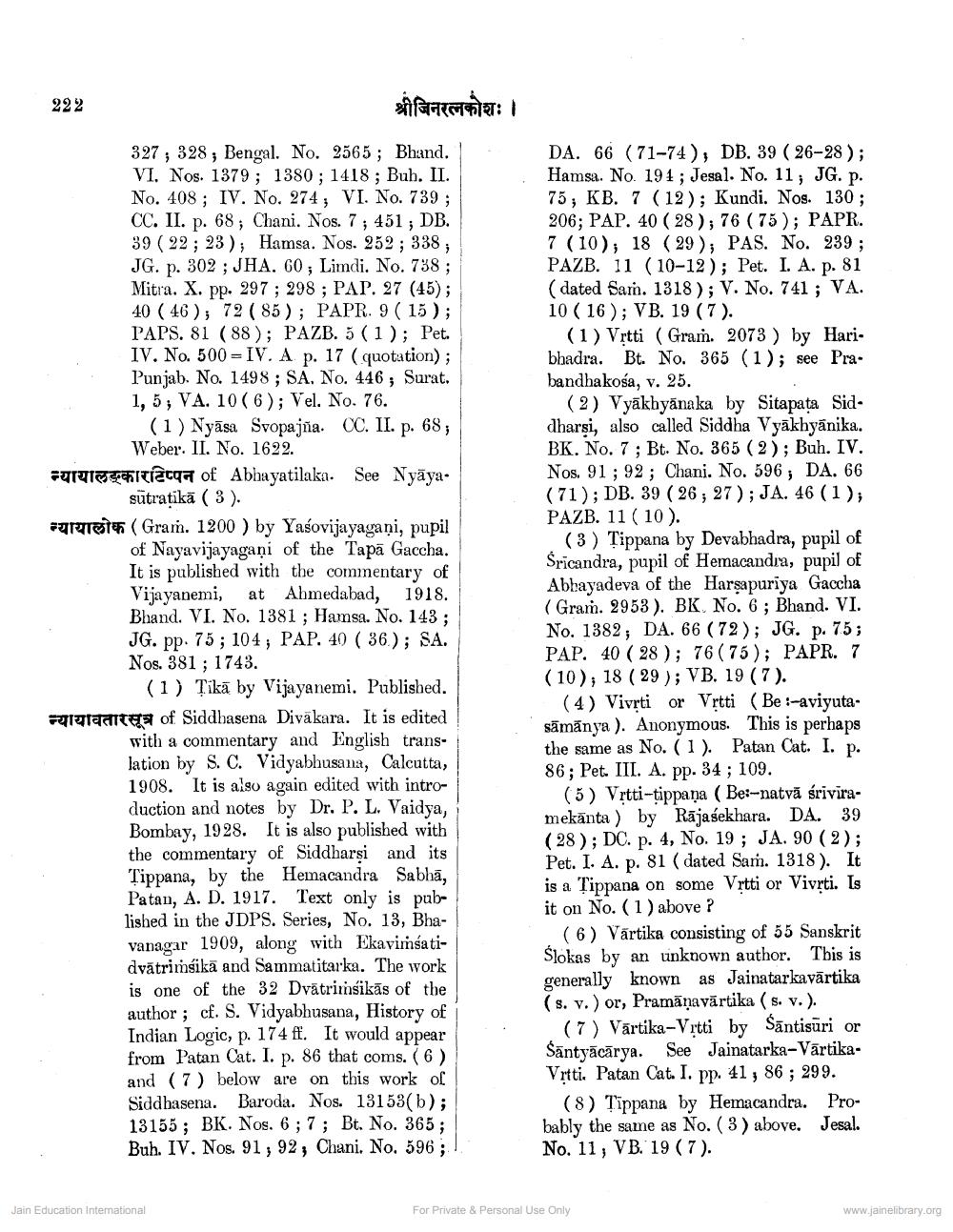________________
222
श्रीजिनरलकोशः।
327, 328; Bengal. No. 2565; Bhand. VI. Nos. 1379; 1380 ; 1418; Buh. II. No. 408 ; IV. No. 274; VI. No. 739 ; CC. II. p. 68; Chani. Nos. 7 ; 451 ; DB. 39 (22; 23 ); Hamsa. Nos. 252; 338; JG. p. 302 ; JHA. 60 ; Limdi. No. 738 ; Mitra. X. pp. 297 ; 298 ; PAP. 27 (45); 40 ( 46 ); 72 ( 85 ); PAPR. 9 ( 15 ); PAPS. 81 (88); PAZB. 5 (1); Pet. IV. No. 500 = IV. A p. 17 (quotation); Punjab. No. 1498 ; SA. No. 446 ; Surat. 1, 5; VA. 10 ( 6 ); Vel. No. 76.
(1) Nyāsa Svopajña. CC. II. p. 68;
Weber. II, No. 1622. sorglitiaqat of Abhayatilaka. See Nyāya.
sūtratikā ( 3 ). Forth (Gram. 1200 ) by Yasovijayagani, pupil
of Nayavijayagani of the Tapā Gaccha. It is published with the commentary of Vijayanemi, at Ahmedabad, 1918. Bhand. VI. No. 1381 ; Hamsa. No. 143; JG. pp. 75; 104 ; PAP. 40 (36); SA. Nos. 381 ; 1743.
(1) Țikā by Vijayanemi. Published. Fylgtaatee of Siddhasena Divakara. It is edited
with a commentary and English translation by S. C. Vidyabhusana, Calcutta, 1908. It is also again edited with introduction and notes by Dr. P. L. Vaidya, Bombay, 1928. It is also published with the commentary of Siddharși and its Tippana, by the Hemacandra Sabhā, Patan, A. D. 1917. Text only is published in the JDPS. Series, No. 13, Bhavanagar 1909, along with Ekavimśatidvātrimsika and Sammatitarka. The work is one of the 32 Dvātrimsikās of the author ; cf. S. Vidyabhusana, History of Indian Logic, p. 174 ff. It would appear from Patan Cat. I. p. 86 that coms. (6) and (7) below are on this work of Siddhasena. Baroda. Nos. 13153(b); 13155; BK. Nos. 6; 7; Bt. No. 365; Buh. IV. Nos. 91, 92, Chani. No. 596; 1,
DA. 66 (71-74), DB. 39 (26-28); Hamsa. No. 191 ; Jesal. No. 11; JG. p. 75; KB. 7 (12); Kundi. Nos. 130; 206; PAP. 40 ( 28 ); 76 ( 75 ); PAPR. 7 (10); 18 (29); PAS. No. 239 ; PAZB. 11 (10-12); Pet. I. A. p. 81 (dated Sam. 1318 ); V. No. 741 ; VA. 10 ( 16 ); VB. 19 (7).
(1) Vrtti (Graṁ. 2073 ) by Haribhadra. Bt. No. 365 (1); see Prabandhakosa, v. 25.
(2) Vyākhyāna ka by Sitapata Siddharsi, also called Siddha Vyākhyānika. BK. No. 7 ; Bt. No. 365 (2); Buh. IV. Nos. 91 ; 92 ; Chani. No. 596; DA. 66 (71); DB. 39 ( 26 ; 27); JA. 46 (1); PAZB. 11 (10).
(3) Tippana by Devabhadra, pupil of Sricandra, pupil of Hemacandra, pupil of Abbayadeva of the Harsapuriya Gaccha (Gram. 2953). BK No. 6 ; Bhand. VI. No. 1382; DA. 66 (72); JG. p. 75; PAP. 40 ( 28 ); 76 (75); PAPR. 7 (10), 18 ( 29 ); VB. 19 (7).
(4) Vivrti or Vrtti (Be :-aviyutasāmãnya). Anonymous. This is perhaps the same as No. (1). Patan Cat. I. p. 86; Pet. III. A. pp. 34 ; 109.
(5) Vrtti-tippaņa (Be:-natvā sriviramekänta ) by Rājasekhara. DA. 39 (28); DC. p. 4, No. 19; JA. 90 (2); Pet. I. A. p. 81 (dated Sam. 1318). It is a Țippana on some Vrtti or Vivrti. Is it on No. (1) above ?
(6) Vārtika consisting of 55 Sanskrit Slokas by an unknown author. This is generally known as Jainatarkavārtika (s. v.) or, Pramāņavārtika ( s. v.).
(7) Vārtika-Vrtti by sāntisuri or Säntyäcārya. See Jainatarka-VārtikaVrtti. Patan Cat. I. pp. 41, 86 ; 299.
(8) Tīppana by Hemacandra. Probably the same as No.(3) above. Jesal. No. 11, VB. 19 (7).
Jain Education Intemational
For Private & Personal Use Only
www.jainelibrary.org




